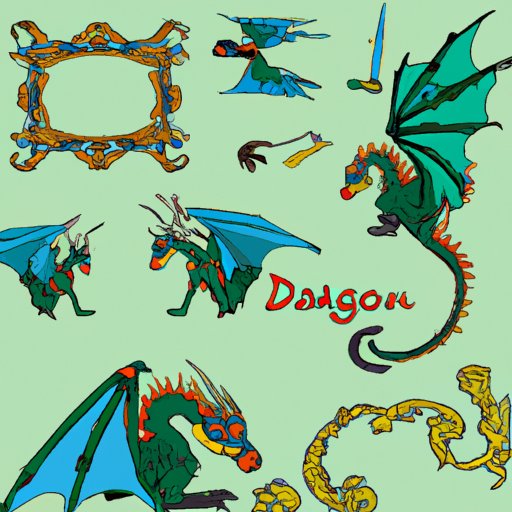
Introduction
Dragons have always been fascinating creatures that have captured the imaginations of people for centuries. From medieval folklore to modern-day movies, dragons have been a constant presence in popular culture. If you’ve ever wanted to learn how to draw these mythical beings, then you’ve come to the right place!
In this guide, we’ll walk you through the step-by-step process of drawing dragons, offer tips and techniques to improve your skills, and explore different styles and cultural interpretations of dragons. Whether you’re new to drawing or an experienced artist, this tutorial will provide you with all the knowledge and inspiration you need to create your own incredible dragons.
Step-by-Step Tutorial
The first step in drawing a dragon is to identify the basic shapes that make up its body. Start with a large oval for the body and a smaller one for the head. Draw a line across the body to indicate where the wings will be. Add the limbs and tail using simple curved lines and circles to indicate the joints. Once you have the basic shapes in place, you can start adding details like the dragon’s face, ears, and horns.
Next, add texture and detail to your dragon’s body. Dragons are known for their scaly skin, so use curved lines to create the outline of the individual scales. Add shading to give the scales depth and dimension. Be sure to vary the size and shape of the scales to make them look more realistic.
Finally, add the finishing touches to your dragon. This could include details like the dragon’s eyes, teeth, and claws. Add shading and highlights to give your dragon a three-dimensional appearance. Congratulations – you’ve just drawn a dragon!
Drawing Tips
If you want to take your dragon drawings to the next level, then consider these tips and techniques:
Use References
If you’re struggling with the anatomy or details of your dragon, then using references can be incredibly helpful. Look up pictures of real animals with similar features, like lizards and crocodiles, and use them as a starting point. You can also find inspiration in other artists’ dragon drawings.
Understand Anatomy
Understanding the basic anatomy of dragons can help you create more realistic and believable drawings. Pay attention to features like the length and shape of the limbs, the number and placement of the horns, and the size and position of the eyes.
Incorporate Shadows and Highlights
Adding shadows and highlights to your dragon drawings can give them depth and dimension. Choose a light source and shade the dragon accordingly, paying attention to the areas that would receive the most and least light. Use highlights to add shine to the scales and bring attention to important features.
Compare and Contrast
Dragons come in a variety of styles and interpretations, from the classic western dragon to the Chinese dragon. Each style has its own unique features and characteristics that make it stand out. Here are some examples:
Western Dragon
The western dragon typically has wings, four limbs, and a long, serpentine body. They are often depicted as fire-breathing and fiercely territorial.
Chinese Dragon
The Chinese dragon is a popular motif in Chinese mythology and culture. They are typically depicted as long and serpentine, with no wings. They are seen as powerful and benevolent creatures and are often associated with water.
Hybrid Dragons
Many artists like to combine elements of different dragon styles to create their own unique hybrid dragons. For example, you could combine the western dragon’s ferocity with the Chinese dragon’s elegance and grace.
Focusing on Features
Once you have a basic understanding of the anatomy and different styles of dragons, you can start focusing on specific features and details:
Wings
The wings are one of the most distinctive features of dragons. They can be leathery, feathered, or even bat-like. Pay attention to the shape and size of the wings, and how they attach to the dragon’s body.
Tail
The tail is another key feature of the dragon’s anatomy. They can be long and serpentine or short and powerful. Think about the different ways a dragon might use its tail – as a weapon, a tool for balance, or even a means of communication.
Scales
Scales are what give dragons their distinctive appearance. Experiment with different shapes and sizes of scales, and add shading and highlights to give them depth and dimension.
Artistic Interpretations
Dragons have taken on many different interpretations throughout history. Here are some examples:
European Dragons
European dragons are often depicted as fire-breathing beasts that hoard treasure. They are typically hunted by brave knights and slain in epic battles.
Eastern Dragons
Eastern dragons, like Chinese and Japanese dragons, are seen as symbols of good fortune and prosperity. They are often depicted as long, serpentine creatures with no wings and are associated with water.
Using Art Tools to Create Different Styles
Choosing the right art tools can help you create different styles of dragon drawings. Here are some examples:
Pencils
Pencils are a versatile tool for drawing dragons. Use different grades of pencils to achieve varying levels of shading and detail. You can also experiment with different types of pencils, like mechanical pencils or colored pencils.
Ink Pens
Ink pens are a great choice for creating bold, dramatic lines in your dragon drawings. You can use different thicknesses of pens to create texture and depth.
Paint
Paint can add vibrant colors and visual interest to your dragon drawings. Experiment with different types of paints, like watercolors or acrylics, to create different effects.
Conclusion
Whether you’re a beginner or an experienced artist, drawing dragons is a fun and rewarding activity. By following these tips and techniques, you can create your own unique dragons and explore different styles and interpretations. Remember to have fun and let your creativity run wild!
If you’d like to learn more about drawing dragons, then check out some of the resources below:





